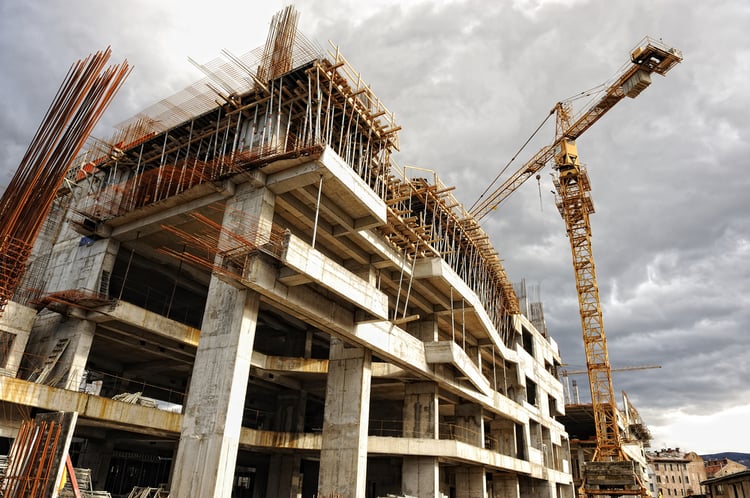The Two Types of Building Emissions: Embodied and Operational Carbon

In many parts of the world, there is growing concern about the environmental impact of the building sector. An example of this is NYC Local Law 97 of 2019, which establishes emission limits for buildings over 25,000 square feet starting from 2024. All buildings that are covered by this law will face a penalty of $268 per metric ton of CO2-equivalent above their respective limit, calculated each year.
Even when operating emissions are lowered, there is another challenge - reducing the embodied emissions of buildings. Architecture 2030 estimated that three materials alone account for 23% of the world’s emissions, when you consider the full impact of their supply chains: steel, concrete and aluminum.
Get a green design for your next building project.
Without targeted actions, embodied carbon could surpass the operating emissions of buildings within the next decades. According to Architecture 2030, embodied carbon could account for 57% of the emissions from new constructions between 2020 and 2040.
Operational Carbon from Buildings: Reduction Strategies

There are many measures that reduce carbon emissions from existing buildings. However, they generally follow two main strategies:
- Reducing energy consumption: Using less kilowatt-hours, cubic feet of natural gas, gallons of heating oil, gallons of diesel, etc.
- Switching to cleaner energy sources: Replacing grid electricity with onsite renewables, switching from combustion to electric heating, etc.
The first strategy reduces the units of energy used by a building, while the second one reduces the carbon footprint of each energy unit. However, both strategies accomplish a common goal: cutting emissions from the building sector.
Each property is unique - carbon reduction measures that are very effective in one building may achieve limited results in another property in the same city. The best starting point is getting a professional energy audit, and simulating the effect of carbon reduction measures with energy modeling software.
Energy bills and building emissions go hand-in-hand. Carbon technology is not only about protecting the environment - there is also an attractive return on investment for building owners, and there are many financing options for green upgrades. PACE loans offer a repayment period of up to 30 years, and they can be easily transferred to other owners if buildings are sold.
Embodied Carbon from Buildings: Reduction Strategies

Unlike operational carbon, which can be reduced by improving a building, embodied carbon has already been released when a new construction is finished. Architecture 2030 proposes three strategies to deal with embodied carbon:
- Reusing construction materials when buildings reach the end of their service life.
- Reducing the initial carbon footprint, when materials are first used in new constructions.
- Sequestering carbon that has already been released into the atmosphere.
There are many technologies that focus on energy efficiency and renewable sources, but more innovation is required to deal with embodied carbon. There are many promising concepts that can be applied in the building sector: design for deconstruction, low-carbon and zero-carbon materials, carbon sequestering materials, carbon sequestering sites, etc.
Another way to reduce embodied emissions is by minimizing the usage of materials from the design stage. BIM modeling software can be used to optimize the layout of building systems, and methods like prefabrication and modular construction can be implemented to reduce waste.
Considerable growth is expected in the building sector within the next few decades, and quick action is needed to prevent a major impact from embodied emissions. According to the United Nations, 68% of the global population will live in cities by 2050, which represents an increase of 2.5 billion from today’s urban population. The sheer volume of new constructions will double the world’s building stock by 2060 - equivalent to 2.4 trillion square feet of building area.
In the case of NYC, Local Law 97 only penalizes operational emissions, based on energy benchmarking from the building sector. However, this does not mean that embodied emissions should get less priority. Also, consider that stringent laws for embodied emissions could be enacted in the future - developers who are already mitigating the impact of materials and construction processes will be better prepared.
Concluding Remarks
Carbon emissions are often associated with transportation, but the impact of the building sector is often overlooked. However, buildings are responsible for both embodied and operational carbon, and different strategies are needed for each type of emissions. The window of opportunity to reduce embodied carbon is also smaller - when a building opens, these emissions have already been released.
Operational emissions can be targeted with a combination of energy efficiency measures, conversion to cleaner sources, and onsite renewable generation. Embodied emissions must be minimized during the design and construction process, while reusing as many materials as possible and sequestering emissions that have already been released.

Michael Tobias
Michael Tobias, the Founding Principal of NY Engineers, currently leads a team of 150+ MEP/FP engineers and has led over 4,000 projects in the US
Join 15,000+ Fellow Architects and Contractors
Get expert engineering tips straight to your inbox. Subscribe to the NY Engineers Blog below.

